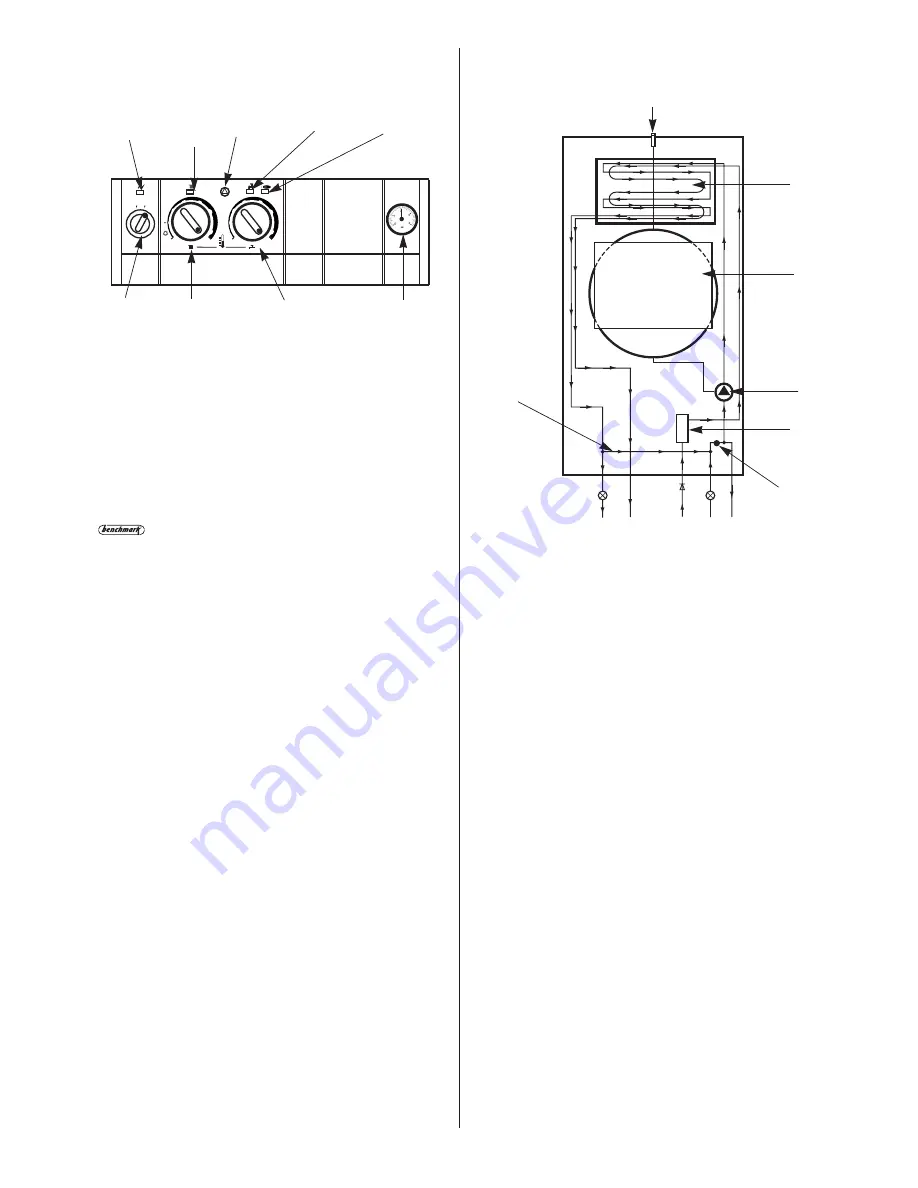
2.6
Controls
Controls for switching the appliance On or Off and for adjusting
the CH and DHW temperatures. The CH control knob also
switches the CH off and on.
A programmable room thermostat or a facia mounted
programmer or clock is available.
A room thermostat and/or an externally mounted programmer
for mains voltage operation may be connected to the appliance.
Only double insulated mains voltage controls not requiring
an earth can be used.
2.7
System
All dirt must be flushed from the system before
connecting the appliance.
The system can be pre-piped and flushed before the appliance is fitted.
The connections in the system must withstand a pressure of
upto 3 bar.
Radiator valves must conform to BS2767: 10:1977.
Table 3 gives the pump head available for the system and the
required temperature differential.
A drain cock must be fitted to the lowest point and an air vent to
the highest point of the system.
2.8
Showers, Bidets, Taps and Mixing Valves
All taps and mixing valves must be suitable for the available
mains pressure and temperatures up to 65°C. It may be
necessary to fit a pressure reducing valve.
Hot and cold mains fed water can be supplied to overrim bidets
but is subject to local water company requirements.
The flow of water from individual outlets varies on all mains fed
systems that are not fitted with flow balancing valves. If a
pressure equalising valve is fitted then the domestic hot water
temperature should be set to maximum.
Thermostatically controlled shower valves give extra comfort
and protection.
2.9
Safety
The appliance must not be operated with the inner casing cover removed.
The gas and electricity supplies must be turned off before
working on the appliance.
Temperature monitoring controls are fitted to prevent overheating.
Automatic frost protection is provided together with automatic
pump seizure protection.
The gas valve solenoids are automatically checked for gas soundness.
IMPORTANT: Where back-flow prevention devices, including
water meters, are fitted the expansion of hot water into cold
water main can be prevented. This can result in a pressure
build-up that may cause damage to the boiler and household
devices such as showers, washing machines etc.
In these cases we recommend that a mini-expansion vessel be
fitted adjacent to the boiler in the cold water pipe.
2.10
Operation
Central Heating
A demand for heat will ignite the burner. It will operate at
minimum pressure for 2 minutes before increasing to the maximum
pressure over a period of 1 minute and then automatically
match the system requirements. At the end of the demand the
burner will go out, the pump will continue to run for up to 4
minutes or the fan for 35 seconds. There is an anti-cycle time of 3
minutes.
Domestic Hot Water
A demand for hot water will ignite the burner. The burner
pressure will immediately rise to maximum.
At the end of the demand the fan will continue to run for 35
seconds if there is no heating demand.
The demand for hot water will override the CH function. In winter
it may be necessary to reduce the flow at the taps to maintain
the delivery temperature.
2.11 Conversion Instructions
The appliance can be converted from LPG to NG and vice versa
by replacing the burner and resetting the gas valve.
To replace the burner and transfer the electrodes refer to Section
15.4.2,3 and 4. The burner part numbers are:
NG (25Si and 28Si)
8 718 120 565 0
LPG (28Si)
8 718 120 566 0
LPG (25Si)
8 718 120 569 0
To reset the gas valve refer to Section 15.4.4, Section 12-
Commissioning and , for setting pressures, Table 1 in Section 3-
Technical Data.
Always check for gas soundness after replacing components in
the gas circuit.
3
Fig. 2. Water flow diagram.
0
I
Fig. 1. Facia controls
Mains
ON/OFF
Switch
Power ON
Indicator
Central Heating
Operation and
Temperature
Control Knob
Domestic
Hot Water
Temperature Control
Knob
Central Heating
Indicator
Light
Domestic Hot
Water Indicator
Light
Burner
Operation Light
System
Pressure
Gauge
Reset
Button
!
1 2 3 4 5
7
8
6
9
10
11
12
1. CH Flow.
2. Domestic Hot Water
Supply.
3. Domestic Cold Supply.
4. CH Return.
5. Relief Valve Discharge.
6. Relief Valve.
7. Domestic Water Flow
Switch.
8. Pump.
9. Sealed System
Expansion Vessel.
10. Bi-thermal Gas to Water
Heat Exchanger.
11. Automatic Air Vent.
12. Fixed By-Pass.
Содержание 28Si
Страница 29: ...29 ...
Страница 56: ...TO REPLACE THE PROGRAMMER Follow the preceding instructions 3 Programmer connection Fig 1 ST5 ...
Страница 57: ...4 OFF TWICE ONCE ON ...




































